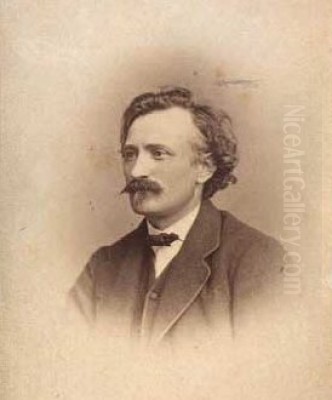
Peter Kornbeck (1837–1894) stands as a notable figure in 19th-century Danish art, particularly esteemed for his meticulous and atmospheric depictions of architecture and evocative landscapes. While perhaps not as globally renowned as some of his Danish Golden Age predecessors or the later Skagen Painters, Kornbeck carved a distinct niche for himself, capturing the essence of historical structures and the allure of foreign lands with a keen eye for detail and a subtle understanding of light. His work offers a valuable window into the artistic currents of his time, reflecting both a continuation of academic traditions and an engagement with the burgeoning interest in realism and picturesque travel.
It is worth noting a point of potential confusion: another Danish individual named Peter Kornbeck was born in 1915, the son of theatre director Eyvind Kornbeck, and pursued studies in engineering. This article, however, is dedicated to the painter Peter Kornbeck, whose life and artistic contributions occurred in the 19th century.
The Artistic Milieu of 19th-Century Denmark
To fully appreciate Peter Kornbeck's contributions, it's essential to understand the artistic landscape of Denmark during his lifetime. The first half of the 19th century was dominated by the Danish Golden Age, a period of exceptional artistic output. Painters like Christoffer Wilhelm Eckersberg, considered the father of the Golden Age, instilled a rigorous approach to observation, perspective, and the faithful representation of reality. His students, including Christen Købke, Martinus Rørbye, Wilhelm Bendz, and Constantin Hansen, further developed these principles, creating iconic images of Danish landscapes, portraits, and genre scenes, often imbued with a sense of quiet nationalism and Biedermeier intimacy.
While Kornbeck's career flourished in the latter half of the century, the legacy of the Golden Age, with its emphasis on technical skill and verisimilitude, undoubtedly shaped the artistic education and expectations of his time. The Royal Danish Academy of Fine Arts in Copenhagen remained a central institution, and its annual Charlottenborg Spring Exhibition was a key venue for artists to showcase their work and gain recognition. Kornbeck himself exhibited at Charlottenborg, indicating his participation in the established art scene.
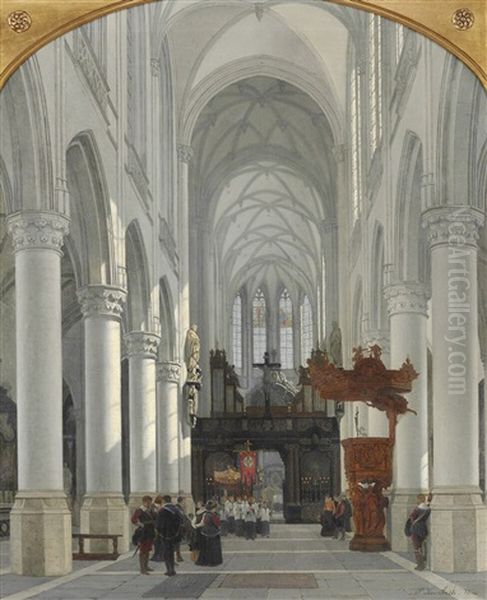
The latter 19th century also saw the influence of international movements like Realism and, towards the end of Kornbeck's life, Naturalism and Impressionism. While Danish art maintained its unique character, artists were increasingly aware of developments in France, Germany, and elsewhere. The desire for objective representation, often focusing on everyday life or unidealized landscapes, found resonance. For Kornbeck, this translated into a commitment to accurately portraying architectural details and the specific atmospheric conditions of the locations he painted.
A Focus on Architectural Grandeur
Peter Kornbeck's reputation is significantly built upon his architectural paintings. He possessed a remarkable ability to convey the scale, texture, and historical weight of buildings, particularly sacred spaces and ancient structures. This genre, with roots in the Italian veduta tradition popularized by artists like Canaletto and Bernardo Bellotto in the 18th century, continued to appeal to artists and patrons who valued both topographical accuracy and romantic evocation.
One of his significant works in this vein is Det Indre af Kirken St. Jacques i Antwerpen (The Interior of St. James's Church in Antwerp), painted in 1870. This oil on canvas, measuring 96 x 78 cm, was notably exhibited at Charlottenborg. Such a subject allowed Kornbeck to demonstrate his mastery of perspective, his skill in rendering complex architectural elements like vaults, columns, and ornamentation, and his ability to capture the play of light filtering through stained glass or illuminating shadowy recesses. Church interiors offered a rich tapestry of textures – stone, wood, metal, fabric – and a profound sense of history and spirituality, all of which Kornbeck would have aimed to convey. His approach likely combined careful on-site sketching with studio execution, a common practice for detailed architectural pieces.
The choice of a Belgian church also highlights the tradition of artists traveling to study and depict significant European landmarks. Antwerp's St. James's Church, with its opulent Baroque interior and the tomb of Peter Paul Rubens, would have been a compelling subject. Kornbeck's depiction would have aimed not just for architectural accuracy but also to evoke the solemn and awe-inspiring atmosphere of the sacred space.
Italian Sojourns: Capturing Light and History
Like many artists of his era, Peter Kornbeck was drawn to Italy, the cradle of classical antiquity and Renaissance art, and a land renowned for its picturesque landscapes and vibrant street life. The "Grand Tour" tradition, though evolving, still held sway, and Italy offered an inexhaustible supply of subjects for painters. Kornbeck's Italian works demonstrate his versatility, moving from the grandeur of ancient ruins to the charm of contemporary life and the intimacy of monastic settings.
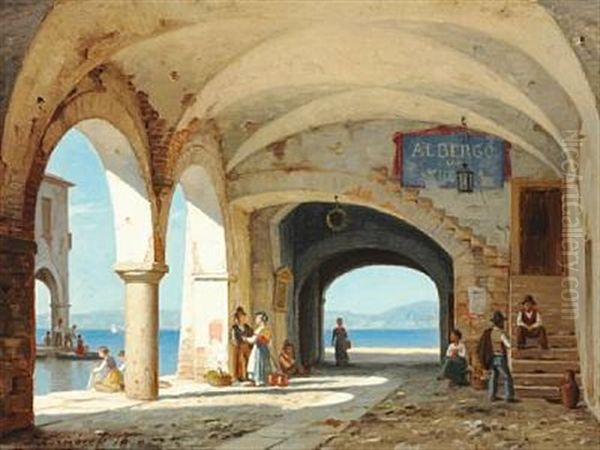
His painting Temple of Concordia, Agrigento Sicily (oil, 54 x 83 cm) is a testament to his engagement with the classical past. The well-preserved Doric temple in Sicily is an iconic subject, and Kornbeck would have focused on its majestic proportions, the warm tones of the ancient stone, and its dramatic placement within the landscape. Such paintings appealed to a contemporary fascination with archaeology and the romantic allure of ruins, a theme also explored by artists like the British painter David Roberts in his depictions of the Near East, or earlier by Giovanni Battista Piranesi with his dramatic etchings of Roman ruins.
Another work, Dalmazia, Mercato a Spalato (Dalmatia, Market in Split), dated 1873 (oil, 45 x 30 cm), transports the viewer to the bustling life of the Adriatic coast, which, while part of the Austro-Hungarian Empire at the time, shared deep historical and cultural ties with Italy. Split, with its Diocletian's Palace forming the core of the old city, offered a unique blend of ancient architecture and contemporary life. A market scene would have allowed Kornbeck to explore not only the architectural backdrop but also human figures, local costumes, and the vibrant interplay of light and color in an outdoor setting. This suggests an interest akin to genre painting, but always grounded in a strong sense of place defined by its architecture.
The painting Buegang i Garda (Archway in Garda), from 1890 (oil, 26 x 34 cm), likely depicts a scene from Lake Garda in northern Italy. Such a subject – an archway – is a classic compositional device, framing a view beyond and allowing for interesting plays of light and shadow. It speaks to Kornbeck's eye for the picturesque, finding beauty in the everyday structures that characterize Italian towns. Similarly, his undated Amalfi (oil, 24 x 36 cm) would have captured the stunning coastal scenery and unique architecture of this famous town on the Amalfi Coast, a subject beloved by artists for its dramatic cliffs and vibrant colors.
An Italian cloister (1878, oil, 44 x 31 cm) further illustrates his interest in architectural spaces imbued with history and tranquility. Cloisters, with their repetitive arches, enclosed gardens, and interplay of light and shadow, offered a contemplative subject matter. Kornbeck's treatment would likely have emphasized the peaceful atmosphere and the textures of aged stone and foliage. These works connect to a broader European tradition of depicting monastic life and architecture, seen in the works of artists from various schools.
Artistic Style: Realism and Atmospheric Detail
Peter Kornbeck's artistic style can be characterized as a form of detailed realism, tempered with a sensitivity to atmosphere and light. His training would have emphasized accurate drawing and perspective, essential for an architectural painter. He employed oil paints with a technique that allowed for both fine detail and broader handling of light and texture.
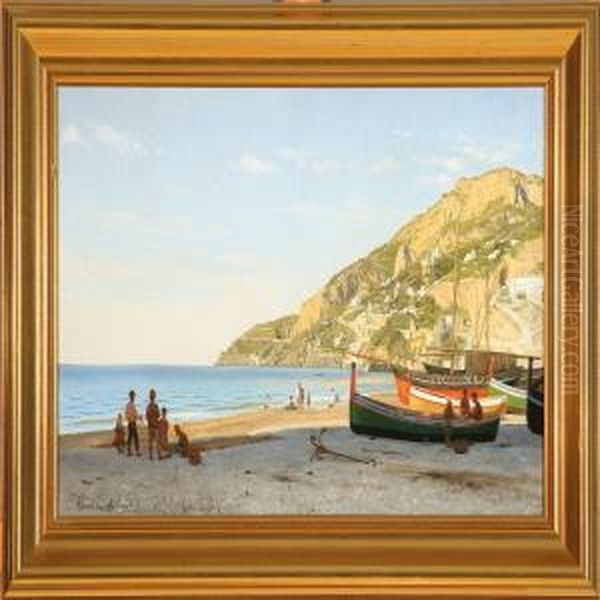
His commitment to detail is evident in the rendering of architectural ornamentation, the textures of stone and brick, and the intricacies of interiors. This precision lent an air of authenticity to his works, making them valuable not only as artistic creations but also as historical records of the places he depicted. However, his work was not merely photographic. He demonstrated a keen understanding of how light defines form and creates mood. Whether it was the diffused light within a grand church, the bright Mediterranean sun on an ancient temple, or the shadowy coolness of an Italian cloister, Kornbeck skillfully used light and shadow (chiaroscuro) to enhance the three-dimensionality of his subjects and to evoke a specific sense of time and place.
It is mentioned that Kornbeck was adept at outdoor creation, suggesting an engagement with plein air (open-air) sketching, if not always the completion of entire canvases outdoors. This practice, which gained prominence in the 19th century, encouraged a more direct and spontaneous response to natural light and atmospheric conditions. This sensitivity is apparent in the freshness and convincing light in many of his landscapes and architectural exteriors.
While firmly rooted in realism, his works sometimes possess what has been described as "decorative elements." This might refer to his compositional choices, a pleasing arrangement of forms, or a subtle emphasis on patterns and textures that enhance the aesthetic appeal beyond mere topographical accuracy. His style aimed for a balance between objective representation and artistic interpretation, creating images that were both informative and visually engaging. This approach aligns him with other 19th-century painters who sought to capture the world around them with fidelity, such as the Danish landscape painter P.C. Skovgaard, known for his detailed depictions of Danish forests, or even the meticulousness found in the works of some Pre-Raphaelite painters in Britain, though their subject matter and symbolism differed.
Contemporaries and Context
While the provided information does not detail specific collaborations or direct rivalries, Peter Kornbeck operated within a vibrant Danish and European art world. He is mentioned alongside other architectural painters like Niels Bredal and August Fischer, suggesting they were considered part of a similar specialization within Danish art. The art scene was one of shared exhibition spaces, like Charlottenborg, and common artistic concerns. Artists would have been aware of each other's work, and a degree of friendly competition or mutual influence is natural in such environments.
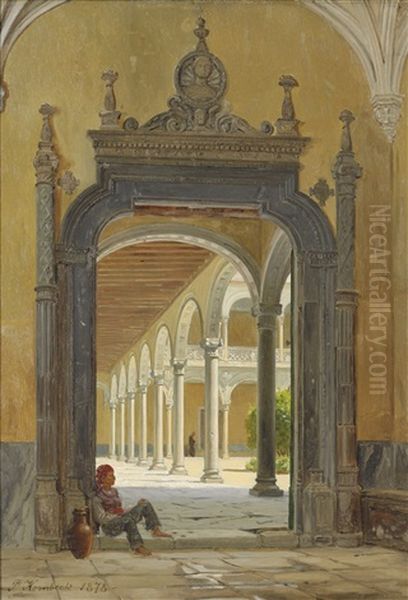
The broader context includes Danish artists who were exploring different facets of realism and naturalism. The Skagen Painters, such as Michael Ancher, Anna Ancher, and P.S. Krøyer, were active during the latter part of Kornbeck's career, focusing on the unique light and life of the fishing community in northern Jutland. While their subject matter and, often, their looser brushwork differed from Kornbeck's architectural focus, they shared a commitment to observing and depicting contemporary reality.
Internationally, the 19th century saw a flourishing of landscape and architectural painting. Artists like Jean-Baptiste-Camille Corot in France, with his poetic landscapes often featuring Italian scenes, or the painters of the Hudson River School in America, capturing the grandeur of the New World, represent parallel developments. In Germany, artists like Caspar David Friedrich (earlier in the century) had imbued landscapes with romantic and symbolic meaning, while later realists focused on more objective depictions. Kornbeck's work, particularly his Italian scenes, participates in this broader European fascination with landscape, travel, and the historical picturesque. His dedication to architectural subjects also aligns him with a lineage of artists who specialized in recording the built environment, a tradition that continued to be important throughout the century. Other Danish artists like Martinus Rørbye had earlier excelled in travel paintings that often featured architectural elements from Italy, Greece, and Turkey, setting a precedent for Danish artists venturing abroad.
Exhibitions, Auctions, and Legacy
Peter Kornbeck's participation in the Charlottenborg exhibitions was crucial for establishing his reputation within Denmark. These exhibitions were the primary showcase for contemporary art and a place where artists could gain critical attention and attract patrons. The fact that his works have appeared in auctions, sometimes with high estimates, indicates a sustained interest in his art among collectors, both during his lifetime and posthumously. Auction records provide valuable insights into an artist's market value and the esteem in which their work is held over time.
His legacy lies primarily in his contribution to the genre of architectural painting in Denmark and his evocative depictions of Italian and other European scenes. His works serve as more than just beautiful images; they are historical documents, capturing the appearance of significant buildings and places in the 19th century. For art historians, his paintings offer insights into the tastes and interests of the period, the tradition of artistic travel, and the enduring appeal of architectural subjects.
While he may not have been a radical innovator in the vein of the Impressionists or later modernists, Peter Kornbeck was a highly skilled and dedicated artist who excelled in his chosen specializations. He upheld the values of careful observation, technical proficiency, and a deep appreciation for the beauty and history embedded in architecture and landscapes. His paintings of church interiors, ancient temples, and picturesque Italian towns continue to resonate with viewers who appreciate meticulous craftsmanship and the ability to be transported to another time and place. His work enriches our understanding of 19th-century Danish art, demonstrating the diverse talents that flourished alongside the more widely celebrated movements. He stands as a fine representative of a tradition that valued both the faithful recording of the world and the evocative power of art.
In conclusion, Peter Kornbeck the painter (1837-1894) was a significant Danish artist whose oeuvre primarily focused on architectural views and landscapes, often inspired by his travels, particularly to Italy. His detailed, realistic style, combined with a sensitivity to light and atmosphere, resulted in works that are both historically informative and aesthetically pleasing. Works like Det Indre af Kirken St. Jacques i Antwerpen and his various Italian scenes, such as Temple of Concordia, Agrigento Sicily and Dalmazia, Mercato a Spalato, showcase his technical skill and his ability to capture the essence of place. He remains an important figure for understanding the breadth of Danish art in the latter half of the 19th century, a period of transition and rich artistic production.